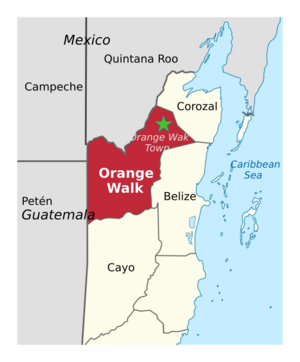Orange Walk District facts for kids
The Orange Walk District is a large and interesting area in the northwest part of Belize. Its main town and capital is Orange Walk Town. This district is known for its rich history, farming, and amazing wildlife.
Quick facts for kids
Orange Walk District
|
|
|---|---|
| Country | |
| Capital | Orange Walk Town |
| Area | |
| • Total | 4,737 km2 (1,829 sq mi) |
| Population
(2016 Estimate)
|
|
| • Total | 50,208 |
| • Density | 10.5991/km2 (27.452/sq mi) |
| ISO 3166 code | BZ-OW |
Contents
Exploring Orange Walk District Villages
The Orange Walk District covers about 4,636 square kilometers (1,829 square miles). It is the second largest district in Belize. It sits between the Belize District and Corozal to the east. To the north is Mexico, and to the west is Guatemala.
Villages and Ancient Sites
Many villages are found across the district. Some of these include:
- August Pine Ridge
- Blue Creek
- Carmelita
- Chan Pine Ridge
- Douglas
- Indian Church
- Guinea Grass
- San Antonio
- San Carlos
- San Estevan
- San Felipe
- San José
- San Jose Palmar
- Nuevo San Juan
- San Lazaro
- San Luis
- San Pablo
- San Román
- Santa Cruz
- Santa Martha
- Shipyard
- Trial Farm
- Trinidad
- Yo Creek
The district is also home to ancient Maya sites. These include Cuello, Lamanai, Noh Mul, and Chan Chich. You can also find the Rio Bravo Conservation and Management Area here. This is a large private nature reserve in the Yalbac Hills.
District Population Facts
In 2010, the Orange Walk District had about 45,419 people. About 13,400 of these people lived in Orange Walk Town. The rest, about 32,019 people, lived in the smaller villages and rural areas.
Economy and Industries
The main town, Orange Walk Town, has about 13,400 people. Many people in the district are Maya mestizos. They are descendants of Mexican refugees who came here after a conflict in the 1840s.
Farming and Food Production
Farming is very important to the district's economy. Sugar cane used to be the main crop. Now, farmers are growing other crops too. These include potatoes, onions, and soya beans. The district also produces dairy products, citrus fruits, beef, and rum.
Growing Tourism and Wildlife
Tourism is becoming a big industry in Orange Walk. The district has lots of tropical wildlife. It also has many interesting archaeological sites. Over 400 types of birds live here. This makes Orange Walk a great place for birdwatching.
Mennonite Communities
Several communities in the district are home to German-speaking Amish Mennonites. They are known for their farming skills.
Important Rivers
The district has two important rivers. The Rio Hondo forms part of the border with Mexico. The New River starts from Belize's largest body of water, the New River Lagoon.
Orange Walk's Past
For over a hundred years, the main industry in Orange Walk was logging. Workers would cut down trees. The timber was then floated down the New River. It went to Corozal Bay, then to Belize City, and finally shipped overseas.
From Logging to Sugar
The logging industry started to decline. Then, refugees from a conflict arrived in the late 1800s. This led to the start of the sugar industry. There is also proof that some Yucatec Maya people lived in the Yalbac hills when the British came to the district.
Historic Forts
Even though Orange Walk District is inland, it has the remains of two old forts. These are Forts Mundy and Cairns. British soldiers built them in the 1800s. They were built after battles between the soldiers and earlier Maya inhabitants. One famous Maya leader was Marcus Canul and his Icaiche Indians.
Languages Spoken
In the Orange Walk District, people commonly speak Spanish, Kriol, and English. The Mennonite community makes up about 37.5% of the district's population. They mainly speak German. In many villages, older people still speak Yucatec Maya.
See also
 In Spanish: Distrito de Orange Walk para niños
In Spanish: Distrito de Orange Walk para niños



